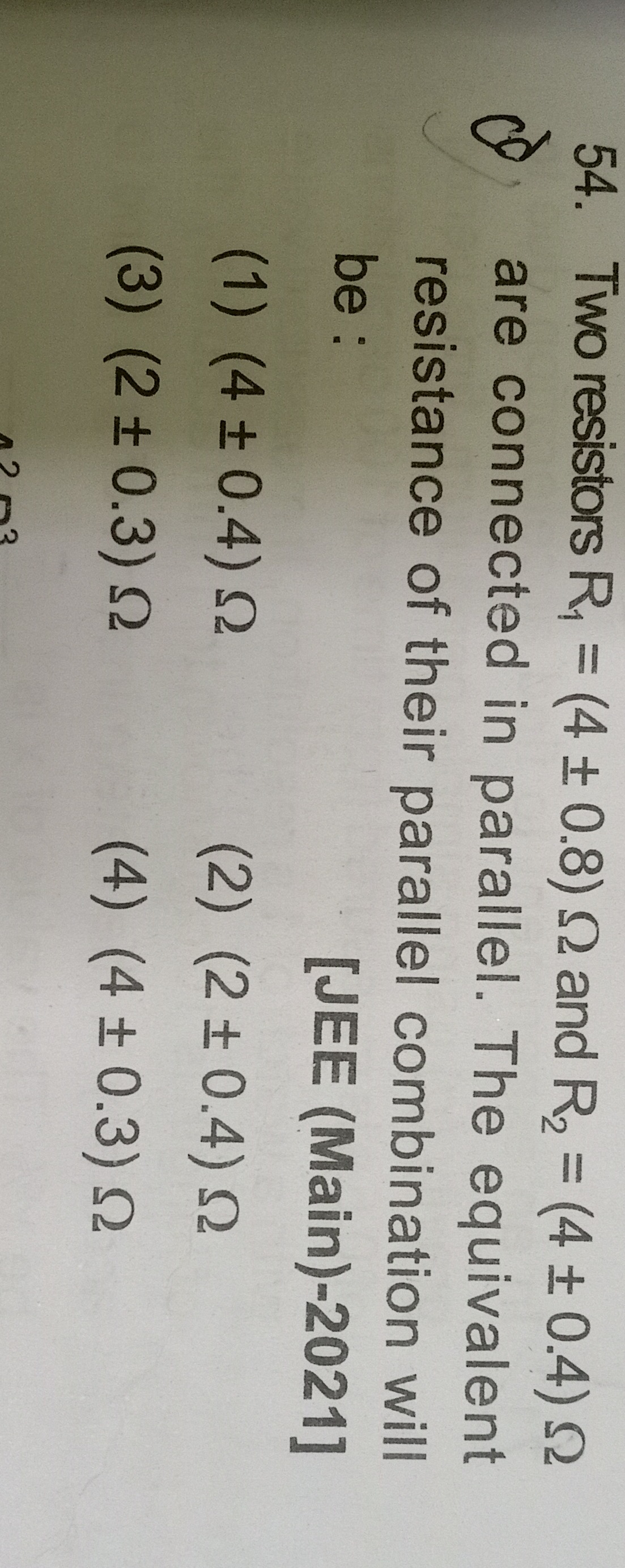Question
Question: Two resistors R₁ = (4 ± 0.8) Ω and R₂ = (4 ± 0.4) Ω are connected in parallel. The equivalent resist...
Two resistors R₁ = (4 ± 0.8) Ω and R₂ = (4 ± 0.4) Ω are connected in parallel. The equivalent resistance of their parallel combination will be:

(4 ± 0.4) Ω
(2 ± 0.4) Ω
(2 ± 0.3) Ω
(4 ± 0.3) Ω
(2 ± 0.3) Ω
Solution
The equivalent resistance Req of two resistors R1 and R2 connected in parallel is given by the formula:
Req1=R11+R21
The given resistances are R1=(4±0.8)Ω and R2=(4±0.4)Ω.
The nominal values are R1,nominal=4Ω and R2,nominal=4Ω.
The uncertainties are ΔR1=0.8Ω and ΔR2=0.4Ω.
First, calculate the nominal value of the equivalent resistance:
Req,nominal1=R1,nominal1+R2,nominal1=41+41=42=21
Req,nominal=2Ω.
Next, calculate the uncertainty in Req. The formula for parallel resistance involves the sum of inverse resistances. Let X=R1. The uncertainty in X is related to the uncertainty in R by ΔX=dRdXΔR.
For X=R−1, dRdX=−R−2. So, ΔX=∣−R−2∣ΔR=R2ΔR.
Let Xeq=Req1, X1=R11, and X2=R21.
The relationship is Xeq=X1+X2.
When quantities are added, their absolute uncertainties add up (for maximum possible error):
ΔXeq=ΔX1+ΔX2.
Calculate ΔX1 and ΔX2 using the nominal values of R1 and R2:
ΔX1=R1,nominal2ΔR1=420.8=160.8=0.05Ω−1.
ΔX2=R2,nominal2ΔR2=420.4=160.4=0.025Ω−1.
Now, calculate ΔXeq:
ΔXeq=0.05+0.025=0.075Ω−1.
Finally, relate ΔXeq back to ΔReq. We have Req=Xeq−1.
The uncertainty in Req is ΔReq=dXeqdReqΔXeq.
For Req=Xeq−1, dXeqdReq=−Xeq−2.
So, ΔReq=∣−Xeq−2∣ΔXeq=Xeq2ΔXeq.
Using the nominal value Xeq,nominal=Req,nominal1=21=0.5Ω−1:
ΔReq=(0.5)20.075=0.250.075=0.25×40.075×4=10.3=0.3Ω.
The equivalent resistance is Req=Req,nominal±ΔReq=(2±0.3)Ω.
